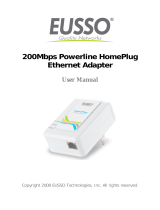
Table of Contents
CHAPTER 1: PRODUCT ............................................................................................................................................................. 4
Introduction .......................................................................................................................................................................... 4
Features ................................................................................................................................................................................. 6
Specifications ...................................................................................................................................................................... 7
CHAPTER 2: INSTALLING THE ADAPTER ............................................................................................................................ 8
Language Setting ................................................................................................................................................................ 8
Package Content ................................................................................................................................................................. 8
Device Overview ................................................................................................................................................................ 10
Hardware Installation ....................................................................................................................................................... 12
Connecting the HomePlug Adapter .............................................................................................................................. 14
WPS configuration. ........................................................................................................................................................... 15
Networking Setup .............................................................................................................................................................. 16
Quick Start (Setup PowerLine Network)...................................................................................................................... 17
CHAPTER 3: BASIC NETWORK INSTALLATION .............................................................................................................. 20
Network Configuration ..................................................................................................................................................... 21
Configuring with your Web Browser ............................................................................................................................ 25
CHAPTER 3: UTILITY INSTALLATION ................................................................................................................................. 26
Utility Installation .............................................................................................................................................................. 27
Utility Configuration ......................................................................................................................................................... 35
Main Tab .............................................................................................................................................................................. 36
Privacy Tab ......................................................................................................................................................................... 40
QoS Tab ............................................................................................................................................................................... 41
Diagnostic Tab ................................................................................................................................................................... 42
About Tab ............................................................................................................................................................................ 44
CHAPTER 4: UI CONFIGURATION ........................................................................................................................................ 45
Status ................................................................................................................................................................................... 46
Statistic ................................................................................................................................................................................ 47
Internet Setting .................................................................................................................................................................. 48
Wireless Settings .............................................................................................................................................................. 50
Wireless Security/Encryption Settings ........................................................................................................................ 53
Advanced Wireless Settings .......................................................................................................................................... 56
Wi-Fi Protected Setup ...................................................................................................................................................... 57
Administration ................................................................................................................................................................... 65
Firmware Upgrade............................................................................................................................................................. 66
Settings Management ...................................................................................................................................................... 67
CHAPTER 5: TROUBLESHOOTING ....................................................................................................................................... 68
Appendix: Product Support & Contact ........................................................................................................................ 69




















